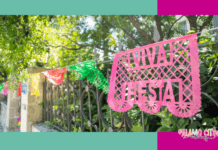I was nearing the end of a fantastic trip to central Mexico and had taken a day trip to Zacatlan in the neighboring state of Puebla. I spent a good portion of my trip meeting artisans, both by chance on the streets of small towns and in markets and intentionally by seeking them out to hear stories and learn about their trade. I knew what I was looking for, and as I walked through the market I was surprised that I was not seeing it. The stands were filled with fruits (which Zacatlan is known for), some wood work, delicious bread, and even some very well-established brands of honey, jams, and candles. The sight of these products, with printed signs and clean tags on items that were set in perfect lines, started to annoy me as my eyes skipped over them and moved onto the next stand. I reached the end of the colorful tarps and walked into the open town square disappointed.
It was then that I noticed the corner of an old building, the kind that came about during the colonization: columns, red roof, archways. I took a sharp left to see what was under the overhang of that building, which lay obscured by tarps from the market scene. This is what I came for.

Women sat on the ground with their tarps covered in piles of embroidered goods and handmade beaded jewelry. I walked slowly past the first two or three women, drinking in all the colors and details. I saw a woman at the end of the row of tarps with a meager selection of garments compared to the others. Kneeling down in front of the tarp, I began looking through the blouses she had stacked towards the front. I know the stitchwork of the area, and this was not it. She was sitting back, pointing at some of the jewelry and telling me that all of the blouses were the same price in a sort of rehearsed, sing-song way. When I got about halfway through the stack, I looked up at her and said, “You didn’t make these.” She looked startled, and then I said, “They’re pretty, but I want to see what YOU made.” Her face lit up, and she immediately got up and started rummaging through a big sack. Why would this make such an impact? Why did it matter so much to her that I asked to see what her hands made?
The art of embroidery in Mexico runs deep through the veins of the culture. It is not a simple past-time that became popular; it pre-dates the colonization. Some embroidery styles even find their origin before the rise of the Aztec empire. The Mayans attribute the gift to Ixchel, the goddess of the moon. The Aztecs also saw it as a divine gift that was granted to them by the goddess Xochiquetzal. I cannot look through the details of the embroidered fabrics and say that they are not divinely inspired. This form of art is so embedded in the culture that upon the birth of a daughter, the midwife or healer (often one in the same) would begin telling the infant of her given gifts and her duties in this life, one of which is the art of storytelling through textiles.
As a young girl grows, she will learn the textile art of her region from her mother, grandmother, and the other women in the community. She will offer up her first embroidered piece to the gods as an offering. The styles and techniques vary from one town to the next and from one unique culture to another. How much variety could there actually be? Well, there are 68 native languages in Mexico, and about 350 dialects among those. We know how much language influences cultures, so that’s a lot of variety! Then, there was colonization, and styles became influenced by Spain as well. The Nahuatl term for the traditional embroidered garment is “huipilli,” which you may have heard as “huipil,” as it is most commonly referred to. These huipils were simple embroidered fabrics with an opening for the head that were stitched at the sides. To this day, you will see women wearing their traditional huipilli. It is not because it is all they know or are comfortable in, it is because the work of their hands contains their cultural identity. You can identify what region a person is from by the style of the embroidery on their garment. Not only that, but many of the regions use their tools to stitch their very dreams and aspirations into their designs. Here are women walking around with their cultural identity, dreams, and hopes on their very shoulders. Powerful.
Traditionally, the bright colors of the threads were dyed using natural dyes. Many regions still use this technique. I was lucky enough to watch the dyeing process using cochinilla, which is an insect that lives on cacti. When the insects are crushed, they produce a rich red dye. Some color dyes take several weeks to achieve the desired hue. There are arduous processes involved in the making of these garments.
The symbolism represented in the textile art of Mexico is as varied as the technique. In the state of Hidalgo there is a style called Tenango, which originated in a small town that is certainly difficult to get to. The fog and the curvy mountain road are less than ideal driving conditions. I had to cancel a drive over due to a simple rain storm that made it impossible to get there. Tenangos are a colorful and inspired representation of nature and one of my personal favorites. My house is adorned with many of the colorful animals and flowers from this region, and I proudly wear this rich culture on my own shoulders. The animals that are popular in this textile originated from cave paintings of flora and fauna that pre-date the Aztec empire. These cave paintings can still be seen and appreciated, and the art that they inspired can now be found all over the world. You might know this style by the name “Otomi.” Otomi is actually the people group behind this wonderful technique.
The meaning behind the designs is so unique to each group. While the Otomi carry on a tradition of honoring nature and representing it, the Yucatan Peninsula holds some designs rich with magical symbols denoting deep religious meanings. Other regions wear their personal hopes, experiences, and beliefs about love and death. In Veracruz and several other regions, the depiction of the flor de cempasuchil (marigold), which is often seen around the Day of the Dead, represents the path that loved ones must take to visit the world of the living. Some people groups use the four-petal flower, which represents the four openings to the underworld. Even simple shapes that we may see as meaningless, such as a stair-step design, can represent anything from water, ocean waves, a serpent, wind, or a deity. Some of the flora can represent a connection to the cosmos. A simple “X” type of stitch can really be an eagle, which depending on the orientation of its head, can denote protection or chastisement.
All of this and more is slowly stitched onto fabrics all over Mexico by old and young hands alike.
Why does this matter? Because right now, somewhere in Mexico, a woman is walking to a market to display the work she labored over for weeks, where someone will not only offer her less than what she is asking, but will haggle for a lower price.
Tourists see machine-stitched blouses with perfect clean lines and floral patterns, or the work of a different region with an entirely different look and history, and they buy them not knowing any better. This, in turn, creates a demand. Consequently, these women then walk to the market to display the work of a machine, that cannot sweat, dream, hope, or pass on traditions. They might also buy the work of another region, because someone else’s life work is selling better than their own, even in their hometown.
People come to buy blouses in the hundreds, pay their price, and sell them for huge profits without recognizing where they came from and how much they represent.
I walk by the window display of a box store selling copy-cat work, and I think of the woman in Zacatlan.
She’s an artist hiding her work, her identity, in a sack. She’s displaying embroidered blouses that she had to buy from someone else, some other region, to guarantee a sale for the day. So when I ask to see what her hands made, I’m telling her that I value who she is. I bought a blouse from her that no one else in this world has. Every time I wear it, I think of her, her family, their trade, and how deep those roots must go. My hope is that the growth does not end with her, but that she is able to pass on her work to the next generation because they, too, see its value.











Besides traveling to Mexico, how would I get a piece of this real embroidery?
Beautifully written, Maria. I love this and can hear the passion for these artisans in your words. <3